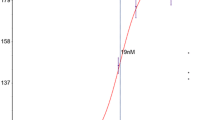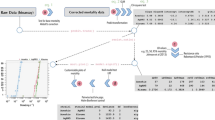Abstract
This article is motivated by the need of biological and environmental scientists to fit a popular nonlinear model to binary dose-response data. The four-parameter logistic model, also known as the Hill model, generalizes the usual logistic regression model to allow the lower and upper response asymptotes to be greater than zero and less than one, respectively. This article develops an EM algorithm, which is naturally suited for maximum likelihood estimation under the Hill model after conceptualizing the problem as a mixture of subpopulations in which some subjects respond regardless of dose, some fail to respond regardless of dose, and some respond with a probability that depends on dose. The EM algorithm leads to a pair of functionally independent two-parameter optimizations and is easy to program. Not only can this approach be computationally appealing compared to simultaneous optimization with respect to all four parameters, but it also facilitates estimating covariances, incorporating predictors, and imposing constraints. This article is motivated by, and the EM algorithm is illustrated with, data from a toxicology study of the dose effects of selenium on the death rates of flies. Other biological and environmental applications, as well as medical and agricultural applications, are also described briefly. Computer code for implementing the EM algorithm is available as supplemental material online.
Similar content being viewed by others
References
Bailer, A. J., and Portier, C. J. (1988), “Effects of Treatment-Induced Mortality and Tumor-Induced Mortality on Tests for Carcinogenicity in Small Samples,” Biometrics, 44, 417–431.
Dempster, A. P., Laird, N. M., and Rubin, D. B. (1977), “Maximum Likelihood from Incomplete Data via the EM Algorithm,” Journal of the Royal Statistical Society, Series B, 39, 1–38.
Dinse, G. E., and Lagakos, S. W. (1983), “Regression Analysis of Tumour Prevalence Data,” Journal of the Royal Statistical Society, Series C, 32, 236–248. Corrigenda, Vol. 33, 79–80, 1984.
Finney, D. J. (1978), Statistical Method in Biological Assay, London: Oxford University Press.
Hill, A. V. (1910), “The Possible Effects of the Aggregation of the Molecules of Haemoglobin on Its Dissociation Curves,” Journal of Physiology 40 (Suppl.), iv–vii.
Jeske, D. R., Xu, H. K., Blessinger, T., Jensen, P., and Trumble, J. (2009), “Testing for the Equality of EC50 Values in the Presence of Unequal Slopes with Application to Toxicity of Selenium Types,” Journal of Agricultural, Biological, and Environmental Statistics 14, 469–483.
Louis, T. A. (1982), “Finding the Observed Information Matrix When Using the EM Algorithm,” Journal of the Royal Statistical Society, Series B, 44, 226–233.
Rao, C. R. (1973), Linear Statistical Inference and Its Applications, New York: Wiley.
Volund, A. (1978), “Application of the Four-Parameter Logistic Model to Bioassay: Comparison With Slope Ratio and Parallel Line Models,” Biometrics, 34, 357–365.
Walker, N. J., Crockett, P. W., Nyska, A., Brix, A. E., Jokinen, M. P., Sells, D. M., Hailey, J. R., Easterling, M., Haseman, J. K., Yin, M., Wyde, M. E., Bucher, J. R., and Portier, C. J. (2005), “Dose-Additive Carcinogenicity of a Defined Mixture of “Dioxin-Like Compounds” ”, Environmental Health Perspectives 113, 43–48.
Author information
Authors and Affiliations
Corresponding author
Electronic Supplementary Material
Below are the links to the electronic supplementary material.
Rights and permissions
About this article
Cite this article
Dinse, G.E. An EM Algorithm for Fitting a Four-Parameter Logistic Model to Binary Dose-Response Data. JABES 16, 221–232 (2011). https://doi.org/10.1007/s13253-010-0045-3
Accepted:
Published:
Issue Date:
DOI: https://doi.org/10.1007/s13253-010-0045-3




